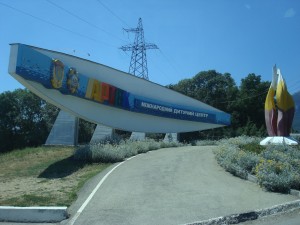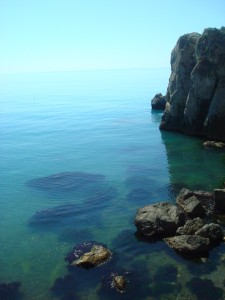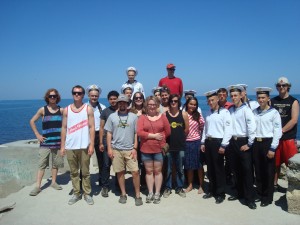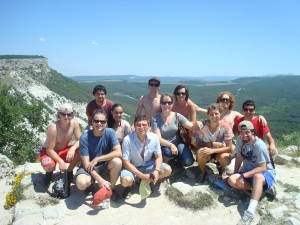Our last Friday in Crimea, we students of Crimean politics and culture embarked on a four day road trip across the southern coast of the peninsula. In typical Colorado College fashion, we managed to see a remarkable amount in such a short period of time. So without further ado, here’s an account of our whirlwind tour.
We started our trip after class on Friday. After a quick lunch and, in my case, some forgetful packing, we piled into the cars and traveled south along the mountainous coast towards the town of Gurzuf. Our hotel for the night was located in what was once the most prestigious children’s camp in the Soviet Union: Artek. Only the very best (or best connected) young Pioneers could hope to come here for the summer. Today the grounds function as a park, with many various hotels and attractions scattered within.


We spent our time in Gurzuf walking along the beach, visiting Chekhov’s cottage, and seeing where Pushkin had spent some time in his southern “exile” (If only I had such problems.)
From there we went on to Yalta, spending a couple hours in what is arguably Crimea’s most famous resort town. In Anton Chekov’s famous short story Lady with a Lapdog, the two lovers meet while on vacation in this town. Yalta was the summer retreat of the nobility and upper classes of the Russian Empire, and during the Soviet Era was used as both a vacation destination and a place where the ill could convalesce in a more temperate climate. On our way out we stopped at the palace where Franklin D Roosevelt, Winston Churchill, and Josef Stalin met to decide what to do with Europe after World War Two. Any student of history would recognize the white arches behind the iconic picture of the three leaders, and it was incredible to stand in the same spot so many years later.
We spent that night in Sevastopol, a city we had talk previously discussed at length. Long the center of Russia’s Black Sea fleet, Sevastopol was ravaged by the Crimean War. Leo Tolstoy’s experiences in the conflict inspired his Sevastopol Sketches, which we had completed the week before. In 1954, Khrushchev transferred Crimea from the Russian Soviet Socialist Republic to the Ukrainian Soviet Socialist Republic, something that at the time was thought to be a mere technicality. But with the fall of the Soviet Union, Crimea became part of an independent Ukraine. Today, Sevastopol has been extended for use by Russian Federation until at least 2045, and the city retains a distinctly Russian character. Russian flags abound, as do St. George ribbons. Sailors are constantly passing to and fro. But Sevastopol is still in Ukraine, and we were reminded of this when we ran into a Ukrainian submarine crew at Greek ruins outside of the city. Only in Crimea, right? They were quite pleasant, in the austere, military type way. They answered our questions and even posed for this photo.

From there we moved on to Bakhchisarai, the capital of the peninsula when it was a Khanate of Crimea, which was established in the 15th century and lasted until the middle of the 18th. The Khanate was ruled by the Crimean Tatar line Girey. The town is farther inland, isolated from the cost but amid beautiful mountains. Our first visit in the ancient city was to visit the remainder of the mosque and educational center of the Crimean Tatar Khanate, as well as the museum that is trying to once again foster the study of Crimean Tatar history and culture. We then immediately embarked on a steep hike up a mountain, to the former city of the Karaim people that had lived alongside the Crimean Tatars. A Turkic people, the Karaim were Jewish, and therefore excluded from the capital itself. They were forced to build on the top of a mountain, and much of the city still stands in impressive ruins on the top of the cliff. Our last activity in Bakhchisarai was to the palace of the Girey’s, which contained not only beautiful architecture but also the famous Fountain of Bakhchisarai, about which Pushkin had written his poem.

Thus, exhausted but extremely happy, we made our way back over those treacherous mountain roads to our hotel and our last few days in Crimea.